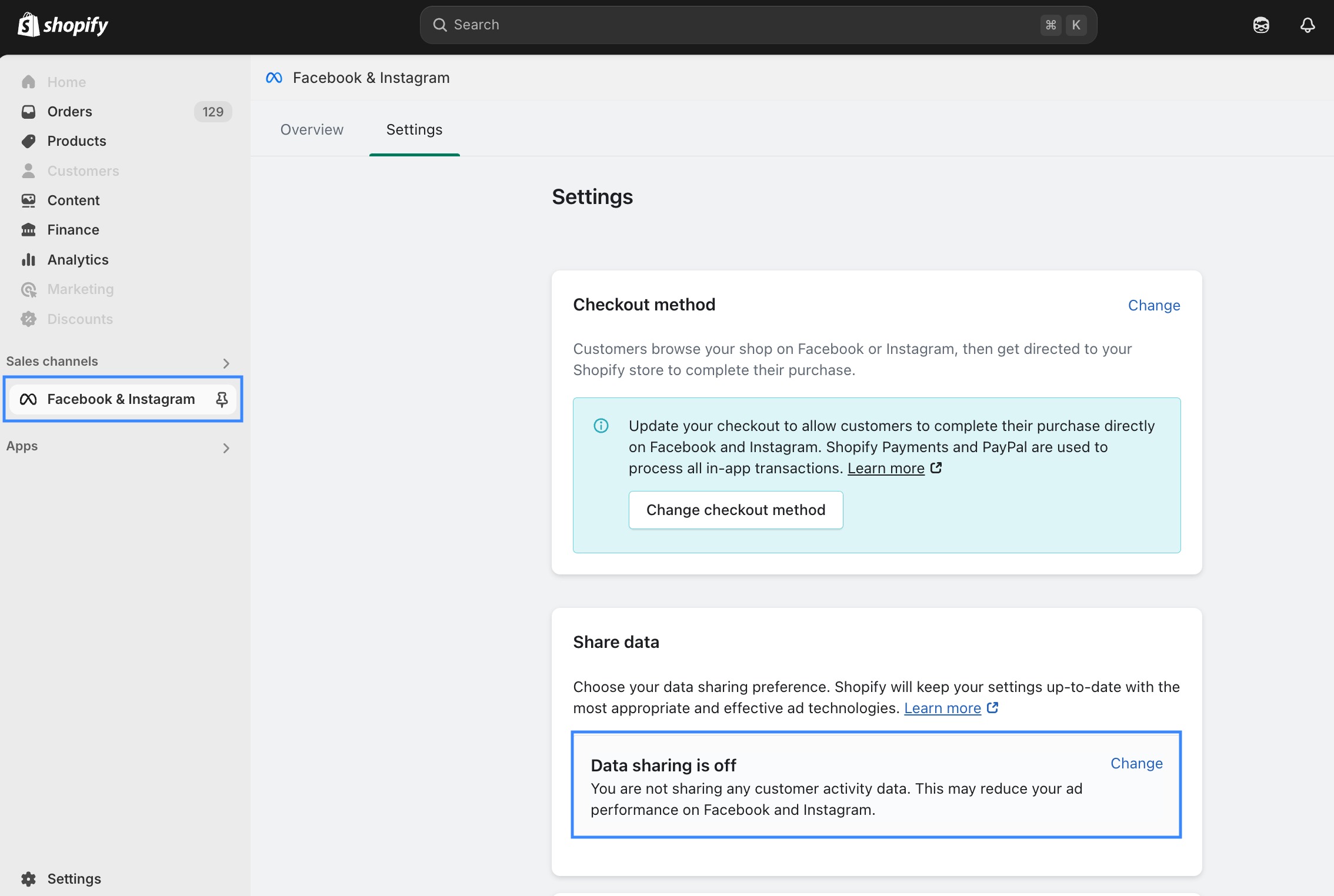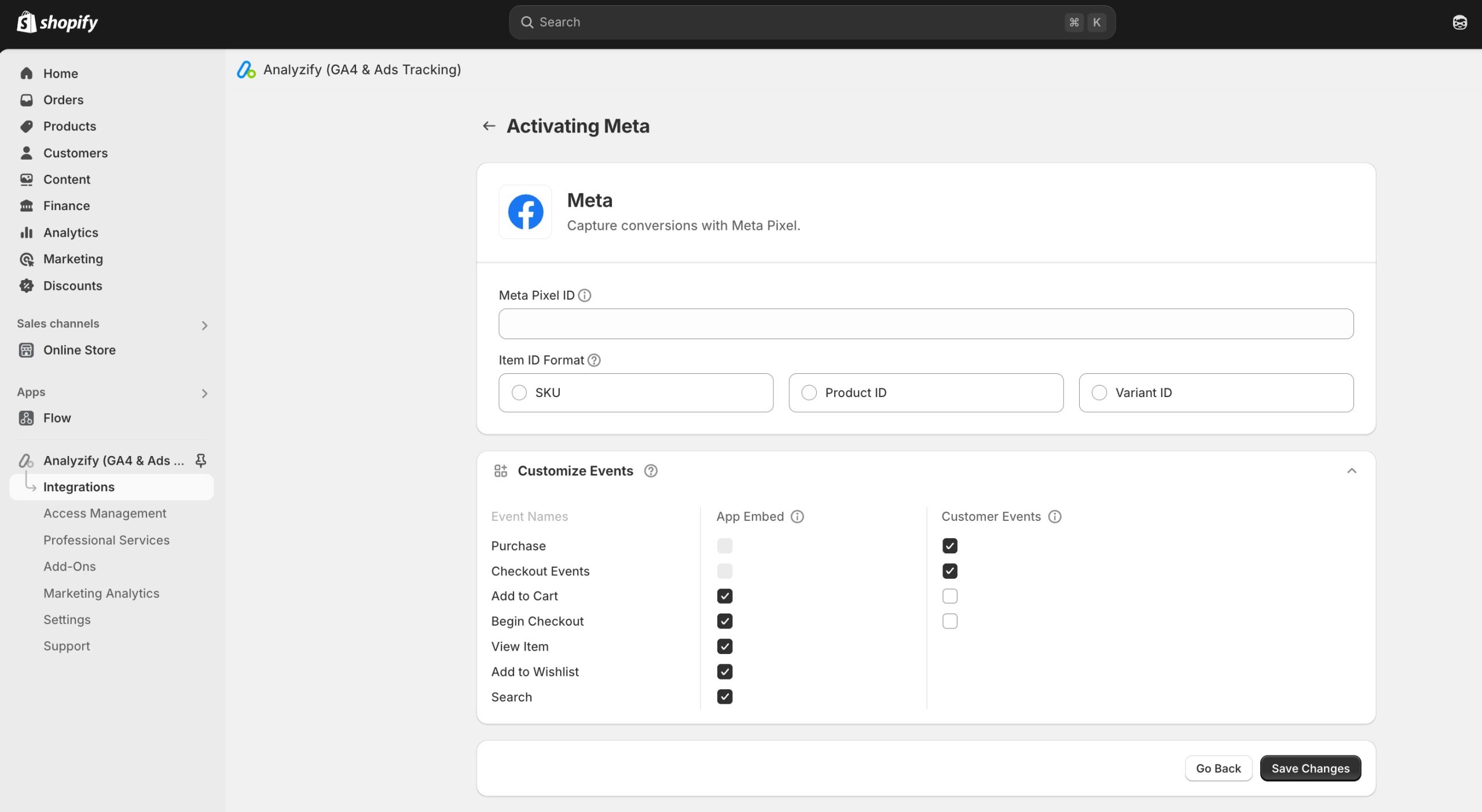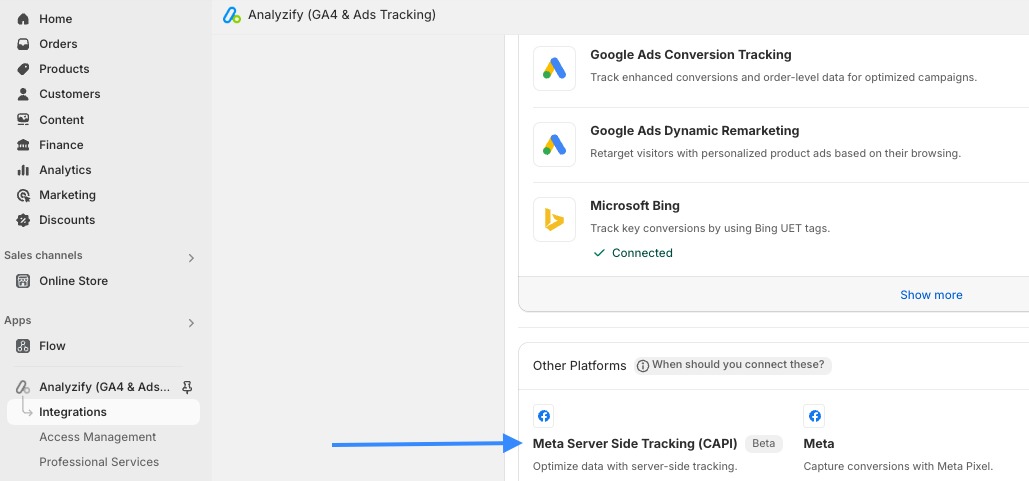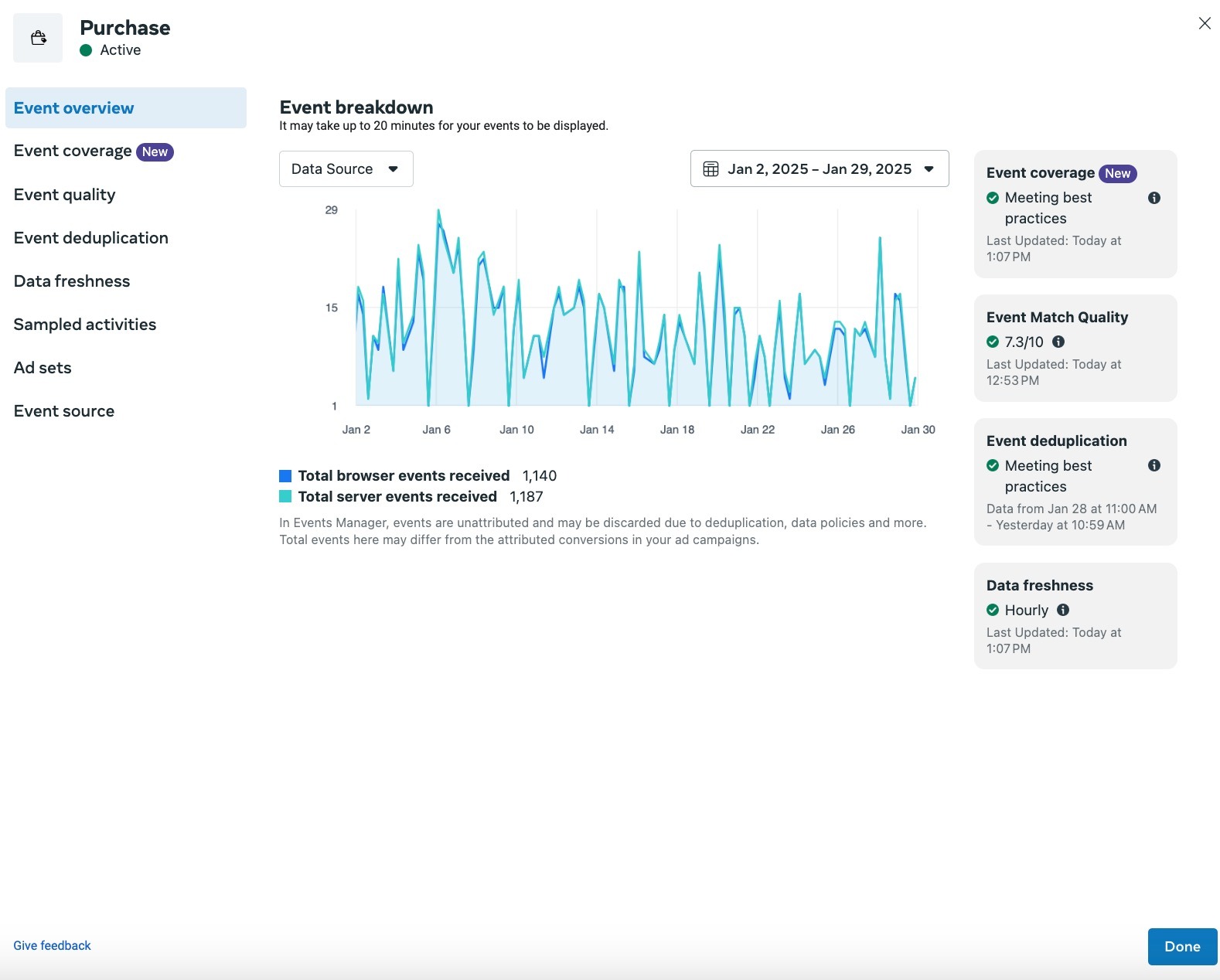With increasing privacy restrictions, browser limitations, and ad blockers, traditional pixel-only tracking simply isn’t enough for solid Facebook (Meta) conversion data.
What is the most effective solution for Shopify merchants, then?
The answer is clear:
Meta (Facebook) server-side tracking with Conversions API (CAPI).
Setting up Meta (Facebook) server-side tracking with Conversions API can provide:
- Significantly improved attribution
- Higher Event Match Quality (EMQ) scores
- Better ROAS calculations
Embracing a setup with a dual approach (both client and server), you can optimize your tracking, feed Meta algorithms better, and stop wasting your ad spend.
With Analyzify, you can set up Meta (Facebook) server-side tracking with Conversions API (CAPI) for your Shopify store in just about 10 minutes – no coding required.
This guide will walk you through exactly how to set up Meta Conversion API and server-side tracking without the technical headache.
![]()
Understanding Meta (Facebook) Conversion API for Shopify
Meta Conversion API is the backbone of server-side tracking implementation.
Before diving into the setup process, let’s understand why implementing Facebook (Meta) server-side tracking is crucial for your tracking setup.
When you rely solely on pixel-based tracking:
- ❌ Ad blockers can prevent your pixel from firing
- ❌ iOS privacy changes can limit what data to be collected
- ❌ Browser restrictions like ITP block cookies
- ❌ You don’t see any EMQ scores
The result? Meta can’t accurately attribute your conversions or optimize your campaigns.
Analyzify’s approach solves these tracking problems by adopting a hybrid system (both client and server-side) as recommended. This approach:
- ✅ Bypasses ad blockers and browser limitations
- ✅ Activates your Meta EMQ (Event Match Quality) scores
- ✅ Provides more reliable & accurate conversion data
- ✅ Stores first-party data inside your Shopify store
- ✅ Enhances your ad optimization and performance
![]()
To learn more about these benefits in detail, check out our comprehensive content on Meta Server-Side Tracking (Meta CAPI) for Shopify stores.
In addition, you can explore Analyzify’s server-side tracking solutions for other marketing platforms:
![]()
Set Up Meta (Facebook) Server-Side Tracking with Conversions API
Analyzify simplifies the process of setting up the Meta Conversion API for your Shopify store.
Here’s how to set up Meta Conversion API quickly and efficiently:
Step 1: Prepare Your Meta Pixel Information
Before beginning, you’ll need:
- Your Meta Pixel ID
- Meta Pixel Secret
- Your content ID format (Product ID, Variant ID, or SKU)
If you’re using the Shopify Facebook & Instagram Sales Channel or any other integration, you’ll also need to disable its data sharing feature (while keeping the app itself for catalog functionality).

Step 2: Set Up Meta Client-Side Tracking
Meta recommends using both client-side and server-side tracking together.
You can configure the Meta Pixel (client-side) through Analyzify’s Direct Integrations or Google Tag Manager.
To start the Facebook (Meta) conversion api setup with Analyzify:
- Navigate to the Integrations section in Analyzify
- Provide your Meta Pixel ID
- Select your Content ID format (ensure it matches your catalog and website)
- Add the Analyzify Meta Pixel to track Purchase and Checkout events

Note: If you’re using Google Tag Manager for Meta client-side tracking, skip this step but continue with the server-side setup.
Step 3: Configure Meta Server-Side Tracking (CAPI)

Now for the server-side implementation to set up Meta CAPI for Shopify:
- Navigate to Integrations within Analyzify
- Click “Connect” under Meta Server-Side Tracking (CAPI)
- Enter your Meta Pixel ID (the same one used for client-side)
- Provide your Meta Pixel Secret:
- In Events Manager, go to your Pixel Settings
- Scroll to the Conversions API section
- Generate a Pixel Secret and copy it for integration
- Choose your Item ID format (must match your Facebook catalog)
- Review the default event settings (optimized for accurate tracking)
- Accept the Data Privacy Notice
- Complete your setup
With these simple steps, you’ve completed the Facebook (Meta) conversion api setup for your Shopify store.
Step 4: Verify Your Implementation

After completing the setup, verify that your Meta (Facebook)data is flowing correctly:
- Go to Events Manager and select your Pixel
- Navigate to the Overview section
- Scroll down to view event activity
- Check that both Server and Browser events are being received
- Verify critical events like Purchase are being tracked
You need more details? Here is a step-by-step guide to setting up Meta server-side tracking through the Conversion API.
Impact of Meta Server-Side Tracking on (Facebook) Event Match Quality (EMQ) Score
One of the key benefits of server-side tracking is the ability to improve Event Match Quality (EMQ) rate.
Meta (Facebook) EMQ measures how effectively Meta can match your events to actual users in their database.
Analyzify’s implementation helps you improve Event Match Quality rate by sending comprehensive customer identifiers:
| Parameter | When Captured | Impact on EMQ |
|---|---|---|
| For logged-in users & at checkout | Very High | |
| Phone | At checkout | Very High |
| Click ID (fbc) | When user arrives via Meta ad | Very High |
| Browser ID (fbp) | Both storefront & checkout | High |
| Geographic info | Both storefront & checkout | Medium |
Higher Meta (Facebook) EMQ scores directly impact your advertising effectiveness by:
- Improving campaign optimization
- Enhancing audience targeting
- Reducing wasted ad spend
- Providing more accurate attribution
When you implement Facebook (Meta) server-side tracking, these improvements happen automatically with Analyzify’s optimized configuration.
![]()
First-Party Data in Shopify with Facebook Conversion API
Implementing Meta Conversion API enables you to leverage first party data in your Facebook advertising.
This first party data approach:
- Gives you more control over what data is shared and when
- Creates a direct server-to-server connection that’s more reliable
- Uses data collected directly by your Shopify store
- Improves matching accuracy through richer customer information
Here’s how specific types of first-party data can enhance your advertising:
- Email addresses: When a customer creates an account or checks out, this identifier helps Meta match your website visitor to a Facebook user, dramatically improving your Meta (Facebook) EMQ score.
- Purchase history: Beyond just tracking conversions, knowing exactly which products a customer purchased allows Meta to find similar users who might buy the same items.
- Cart value data: Knowing a customer’s average order value helps Meta target users who are likely to spend similar amounts.
- Product category preferences: If a customer frequently browses or purchases items in specific categories, this data helps target users with similar interests.
- Geographic information: Customer shipping addresses provide valuable location data that improves targeting precision.
Unlike third-party cookies, which face increasing restrictions, first party data provides a sustainable foundation for your marketing efforts once you implement Meta server-side tracking via the CAPI.
Conclusion: What Meta (Facebook) Server-Side Tracking Is — and What It Isn’t
To wrap up, let’s clear up some common misunderstandings about Facebook (Meta) Conversion Api setup:
- Misconception 1: “You should send all events server-side.”
- Reality: While server-side tracking is powerful, behavioral events often work better with client-side tracking. The optimal approach is using both methods together.
- Misconception 2: “Server-side tracking means you don’t need pixels anymore.”
- Reality: Meta actually recommends a dual approach – sending events from both the pixel and server-side with matching event IDs for deduplication. This maximizes data reliability.
- Misconception 3: “All platforms handle server-side events the same way”
- Reality: Each platform has unique requirements and capabilities.
- Misconception 4: “Setting up server-side tracking for Facebook requires technical expertise.”
- Reality: With solutions like Analyzify, you can implement Facebook (Meta) server-side tracking in minutes without any coding knowledge.
































